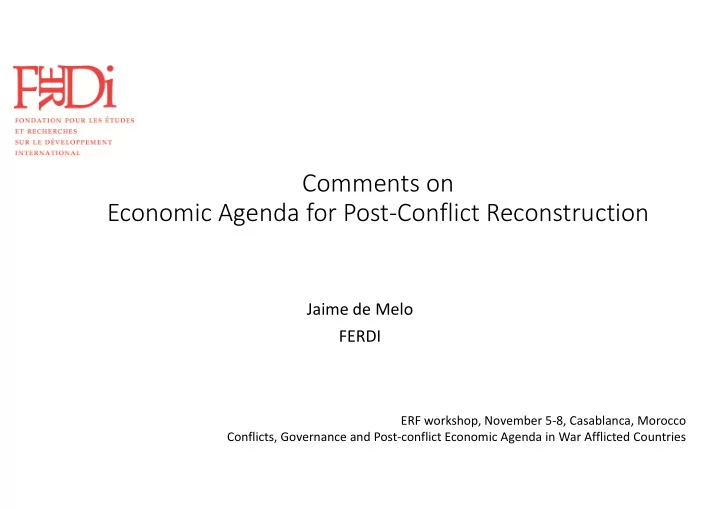

Comments on Economic Agenda for Post‐Conflict Reconstruction Jaime de Melo FERDI ERF workshop, November 5‐8, Casablanca, Morocco Conflicts, Governance and Post‐conflict Economic Agenda in War Afflicted Countries
Outline • Ambitious, Comprehensive thematic paper for multi‐country Study : Iraq, Libya, Syria, Yemen • Paper covers a lot ground with important recommendations on design of macro policies in post‐conflict situation • Remarks • Methodology • Detecting MENA Speficities • Macro Policies and Benchmarking
Methodology Project in the footsteps of comprehensive country studies (OECD, WORLD BANK, etc) but only 4 countries makes it difficult to draw up a ‘common’ methodology to tease out conclusions Paper relies on two plausible premisses o Change/scratch institutions o Prospect for Stability key for stability; Access to RPGs But what is the more plausible framework for institutions in the 4 countries? Same or different? o Acemoglu et al. (2005): Slow evolution as a result of change in the balance of power vs. Transaction costs view o Kuran (2010) Islamic law o Develop/adapt an Institutional diagnostic tool (See EDI project for a recent example)
Detecting MENA Specificities o Inequality down, but not perception. Is this a MENA specificity? Why? Manipulation by social media? Scatter plot of perceptions (e.g. happiness) on indicators: ELF, Gini, FEW index, unemployment, etc... Any indicators of public goods o What other MENA specificities? Institutions ? Islamic law (Kuran) Prospects for benchmarking macro in small sample of conflict‐ ridden countries (see Melo and Ugarte (2012) for larger sample of MENA countries) Commonalities vs. specificities for the 4 countries
Macro Policies and benchmarking o Macroeconomic Policies Inflation control Key since adverse effects on income distribution Fiscal stabilization taking into account Aid and resource rents Improve CBI (low in middle East) o Any prospects for benchmarking macro with a larger sample of conflict‐ridden countries (see Melo and Ugarte (2012) for larger sample of MENA countries)? o Synthetic control methods à la Abadie et al. (2015). Objective is to find commonalities vs. specificities in the macro policies of countries exiting conflict
References Abadie, A., A. Diamond, J. Hainmuller (2015) «Comparative Politics and the Synthetic Control Method», American Journal of Political Science Acemoglu, D., S. Johnson, J Robinson (2005) «Institutions as a Fundamental Cause of Long Run Growth» in Aghion and Durlauf eds. Handbook of Economic Growth , North‐Holland Diop, N., D. Marotta and J. de Melo (2012) Natural Resource Abundance, Growth and Diversification in the Middle East and North Africa , World Bank Institutional Diagnostic Tool, Economic Development and Institutions Project https://edi.opml.co.uk/research‐cat/institutional‐diagnostic‐tool/ Kuran, T. (2010) The Long Term Divergence: How Islamic Law Held Back the Middle Eas t, Princeton University Press Melo J. de and C. Ugarte (2012) «Resource and Abundance and Growth: Benchmarking MENA with the Rest of the World» in Diop et al. 2012
Recommend
More recommend